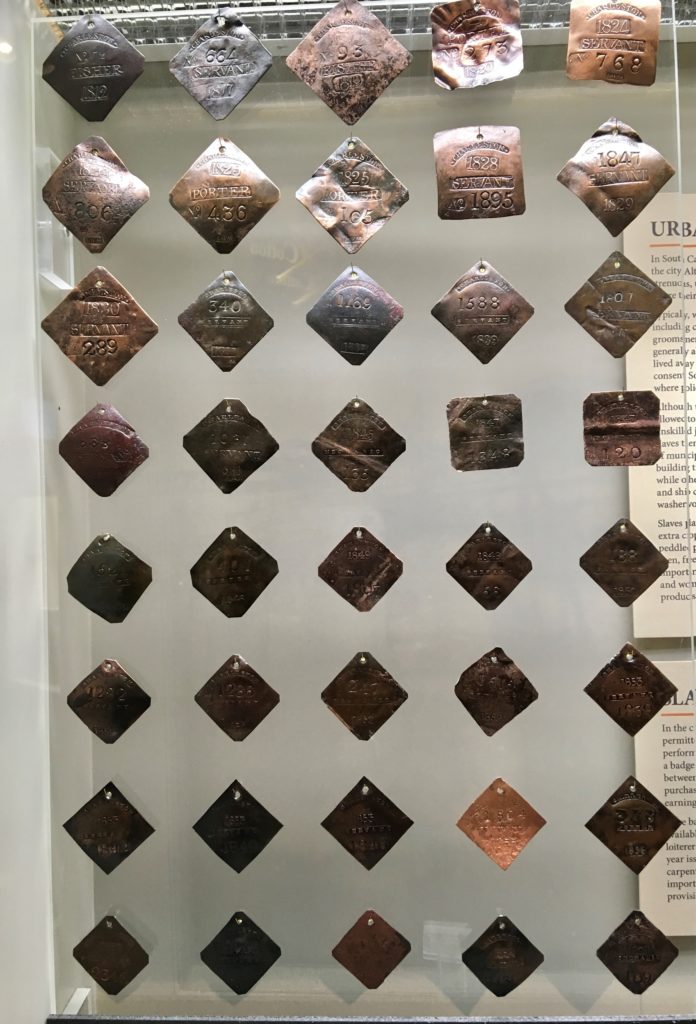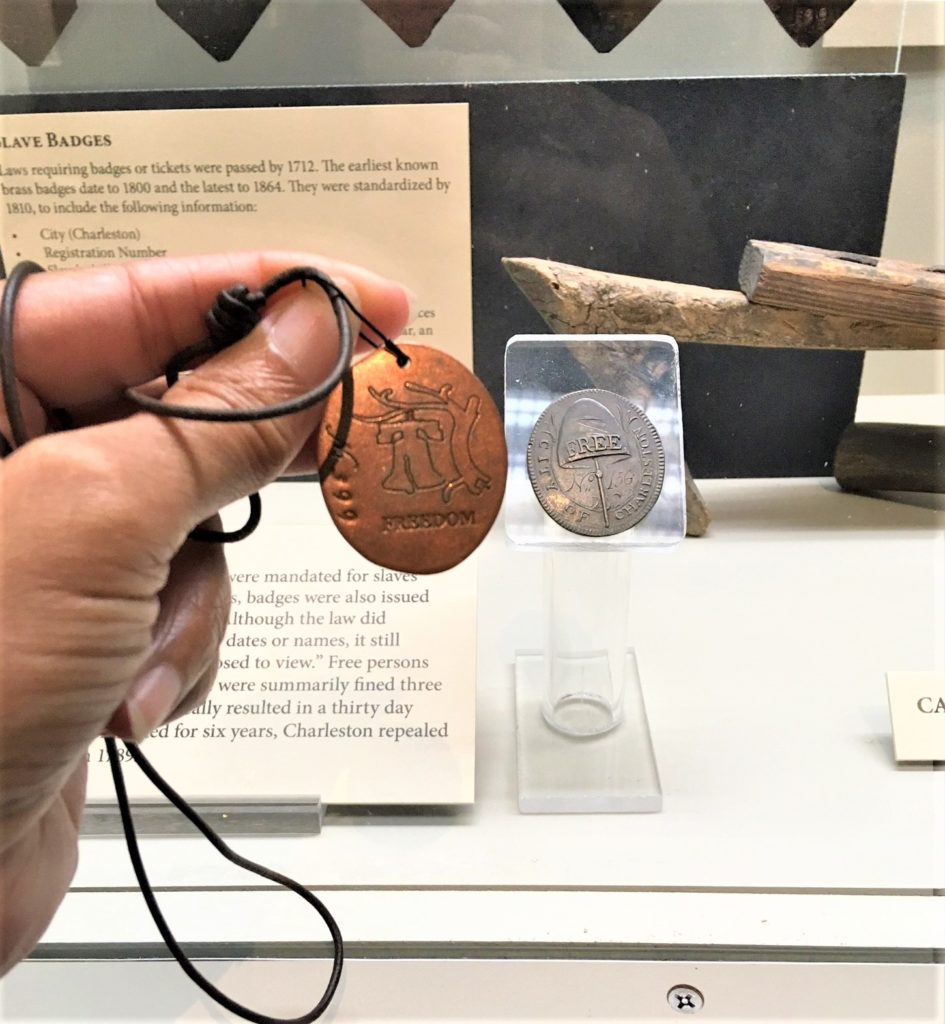In history, the freedom tag was a derivative of metal slave tag or badge that was used in several local southern jurisdictions to patrol hiring. Whether an enslaved craftsman/woman was able to hire themselves out or be hired out by their enslaver, some sort of regulating mechanism was often used and outlined in the laws of cities such as Norfolk, New Orleans, Savannah and Charleston, SC. Written contracts, tickets and metal badges/tags were some of the mechanisms deployed for trades engaged in by enslaved workers such as: tanner, barber, butcher, bricklayer, fruiterer, fisher, mechanic, porter, and servant. A fee was paid to city officials for the issuance of slave tags, renewable annually. In South Carolina, a law was created in 1722 that required a certificate or note to be written up to govern the employment understanding between an enslaver and employer wishing to make use of enslaved labor. In Charleston (where more slaves were imported through than any other American city), a 1751 law required an enslaved hire to wear badges or tickets. The laws evolved in response to the articulated complaints of whites who felt their financial opportunities were compromised by the existence of cheaper enslaved labor that created competition for them. The number of enslaved men and women who hired themselves out using this system, enabling them to save amounts to purchase desired things as well as their freedom and/or that of family members, will never fully be known. They were to be worn, preferably visible, and produced for inspection upon demand. The system continued in many places in the country until chattel slavery was abolished in the country.
The Charleston Museum has one of the largest collections on display of recovered slave badges.

Free Black and Mulatto inhabitants were often thought to be a bad influence in places where slavery was embraced. Many influential enslavers feared rebellion, and mistrusted the activities of free Blacks and Mulattos. Efforts to get the free and freed out of the sight of those forced to labor resulted in many initiatives in the country. Several states enacted laws aimed at expelling their population of free Black and Mulatto from their states to Liberia, much like how white criminals from other countries were expelled to the shores that would become the USA. Some states enacted laws that mandated the freed unwilling to go to Liberia be arrested and transported to another state, or that they renounce their freedom if staying. The metal freedom tag, worn suspended by a string or like a button, was used to identify free Black and Mulattos inhabitants. It emerged in Charleston in 1783 when a law was enacted that required every free person of color over the age of 15 to get one and wear it suspended by a string. Stiff penalties including physical punishment or sale into slavery existed for anyone wearing one that didn’t belong to them. Most of the ones recovered are made of copper. Similar punishments existed for having a certificate of freedom that was counterfeited or didn’t belong to you.
Tags for slave hire continued to be made up to the Civil War, as did certificates of freedom. Authentic free tags and badges are extremely rare to find due to the limited places and period of time in which they were issued. Unlike the slave hire badge that needed renewal with a fee, the free one seems to not have needed annual renewal with fee. Efforts of the American Society for Colonizing the Free People of Color of the United States, founded by men like Francis Scott Key and George Washington’s nephew, Supreme Court Justice Bushrod Washington, would have made the free tag largely obsolete since the prevailing thought at the time was that free Blacks could not be integrated into white America. Reports indicate that modern collectors have paid $30,000 and up for them.
The system of free tags/badges didn’t spread across the country. The Certificate of Freedom was more prevalent though less durable. Paper was fragile and subject to loss, theft or damage, and were usually only good for a short period of time for travel purposes. Black and brown skin carried a presumption of slavery and a burden of the proof of freedom. The only ironclad proof of freedom was being white.
What kind of country would the United States be if it hadn’t been built upon these created systems and those of chattel slavery? Struggles for equal rights and protections are prevalent in US history (there are too many to list here) and have always required assistance from other allies to be successful. The enslaved who made the decision to self-liberate frequently needed the help of free Blacks and Mulattos and whites to be successful. The 1963 March on Washington pin portrayed a white and black handshake. Freedom rides into the south to test enacted laws outlawing segregation in interstate travel were interracial. Brown vs Bd of Education finally desegregated schools, but didn’t apply to Hispanic segregation. The list goes on and on.
Let’s not forget this history of the place where the Declaration of Independance was created but subsequently interpreted to not apply to every race. To understand how far we’ve come and if the quest for true equality has been accomplished, we have to measure it according to who we were and where we’ve been as a country. Some freedom struggles aren’t over yet, because the fights evolved to appear different. There is usually intersection and interconnections between movements, visible if you care and look. We often have a common connection, and things aren’t just “my struggle” or “your struggle.” There is strength in numbers, and divide and conquer is an extremely effective strategy.
Get your freedom tag and wear yours proudly! Consider what it represents, and be mindful of the ways that you can maybe help with a struggle that you see but isn’t yours. The government dropped the concept of the free tag a long time ago, but we’re picking it up and repurposing it with our own design. It’s centered around the Liberty Bell suspended from a tree branch, adopted by abolitionist groups in the 1830s and suffrage ones later to represent their causes, because of a little known story about the bell. Made also of copper (70%), the first bell made in 1751 cracked on the first test ring. A crack eventually formed on the replacement bell and was purposefully widened to prevent further spread. Perhaps symbolic, another crack developed up through the word “liberty” on it which silenced the bell forever. No one living has heard the actual bell ring.
Our adaptation of the free tag posed next to a rare historic one at the Charleston Museum:

The Liberty Bell – Independence National Historical Park (U.S. National Park Service) (nps.gov)
Mechanic badge #135 issued in 1845: